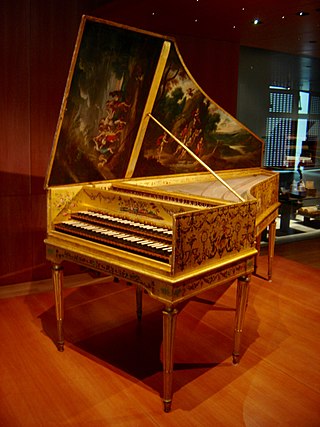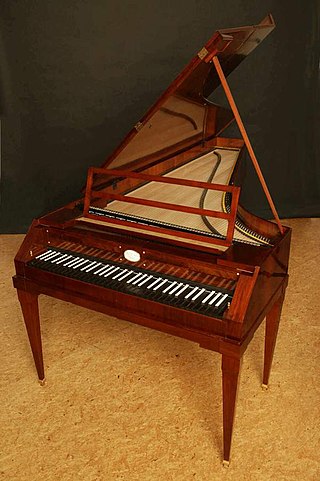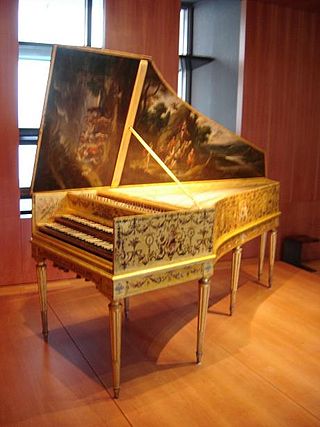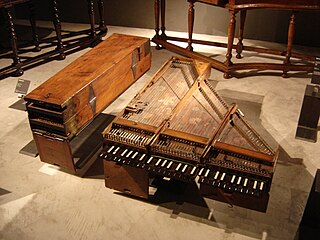
A harpsichord is a musical instrument played by means of a keyboard. This activates a row of levers that turn a trigger mechanism that plucks one or more strings with a small plectrum made from quill or plastic. The strings are under tension on a soundboard, which is mounted in a wooden case; the soundboard amplifies the vibrations from the strings so that the listeners can hear it. Like a pipe organ, a harpsichord may have more than one keyboard manual, and even a pedal board. Harpsichords may also have stop buttons which add or remove additional octaves. Some harpsichords may have a buff stop, which brings a strip of buff leather or other material in contact with the strings, muting their sound to simulate the sound of a plucked lute.

A keyboard instrument is a musical instrument played using a keyboard, a row of levers that are pressed by the fingers. The most common of these are the piano, organ, and various electronic keyboards, including synthesizers and digital pianos. Other keyboard instruments include celestas, which are struck idiophones operated by a keyboard, and carillons, which are usually housed in bell towers or belfries of churches or municipal buildings.

Bartolomeo Cristofori di Francesco was an Italian maker of musical instruments famous for inventing the piano.

A spinet is a smaller type of harpsichord or other keyboard instrument, such as a piano or organ.

A fortepiano, sometimes referred to as a pianoforte, is an early piano. In principle, the word "fortepiano" can designate any piano dating from the invention of the instrument by Bartolomeo Cristofori in 1698 up to the early 19th century. Most typically, however, it is used to refer to the mid-18th to early-19th century instruments, for which composers of the Classical era, especially Haydn, Mozart, and the younger Beethoven and Hummel, wrote their piano music.

A clavicytherium is a harpsichord in which the soundboard and strings are mounted vertically facing the player. The primary purpose of making a harpsichord vertical is the same as in the later upright piano, namely to save floor space. In a clavicytherium, the jacks move horizontally without the assistance of gravity, so that clavicytherium actions are more complex than those of other harpsichords.

Johann (Georg) Andreas Stein was an outstanding German maker of keyboard instruments, a central figure in the history of the piano. He was primarily responsible for the design of the so-called German hammer action. Pianos with this hammer action, or its more developed form known as the Viennese action, may be said to be appropriate for the performance of the piano music of Haydn, Mozart, and the early Beethoven.

Ferdinando de' Medici was the eldest son of Cosimo III de' Medici, Grand Duke of Tuscany, and Marguerite Louise d'Orléans. Ferdinando was heir to the Grand Duchy of Tuscany, with the title Grand Prince, from his father's accession in 1670 until his death in 1713. He is remembered today primarily as a patron of music. An excellent musician himself, he attracted top musicians to Florence and thus made it an important musical center. Through his patronage of Bartolomeo Cristofori, Ferdinando made possible the invention of the piano.

Gottfried Silbermann was a German builder of keyboard instruments. He built harpsichords, clavichords, organs, and fortepianos; his modern reputation rests mainly on the latter two.

Pascal-Joseph Taskin was a Belgium-born French harpsichord and piano maker.
The oval spinet is a type of harpsichord invented in the late 17th century by Bartolomeo Cristofori, the Italian instrument maker who later achieved fame for inventing the piano. The oval spinet was unusual for its shape, the arrangement of its strings, and for its mechanism for changing registration.

William Richmond Dowd was an American harpsichord maker and one of the most important pioneers of the historical harpsichord movement.

The harpsichord was an important keyboard instrument in Europe from the 15th through the 18th centuries, and as revived in the 20th, is widely played today.
Americus Backers, sometimes described as the father of the English grand pianoforte style, brought the hammer striking action for keyboard instruments from his master Gottfried Silbermann's workshop in Freiburg to England in the mid-18th century. Unlike the eleven other ex-apprentices of Silbermann who followed him to England and built square pianos with his action, Backers developed Silbermann's action into a reliable, powerful and responsive form that he built into a grand harpsichord case and added two tonal effects – una corda and damper lift – activated by pedals built into the dedicated trestle stand, again his original innovation. This new instrument altered the landscape of English music, causing composers and musicians to consign the plucked string harpsichord and its music to history. It is upon Americus's design that the modern grand pianoforte we know today is based.

The spinettone was a kind of harpsichord invented in the late 17th century by Bartolomeo Cristofori, who was later the inventor of the piano. Other names for this instrument were spinettone da teatro, spinetta traversa.

The folding harpsichord was a kind of harpsichord meant for travel. Since it could be folded up into a fairly compact space, it was more easily transported than a conventional harpsichord. The folding took place on hinges and was in the longitudinal dimension, preserving the tension on the strings. The folded instrument formed a package about the size of a large suitcase.
Philip Ralph Belt was a pioneering builder of pianos in historical style, in particular the 18th century instruments commonly called fortepianos. His pianos were modeled on instruments made by historical builders, particularly Johann Andreas Stein and Anton Walter. Belt's pianos played a role in the revival of performance on historical instruments that was an important trend in classical music in the second half of the 20th century and continues to this day.
Leopoldo Franciolini (1844–1920) was an Italian antique dealer who was active in the late 19th and early 20th centuries. He is remembered as a fraudster who sold faked and altered historical musical instruments. To this day his work is a barrier to the scholarly study of instruments of the past.

Girolamo Zenti was an Italian harpsichord maker and organ builder in the 17th century. He is known as the probable inventor of the bentside spinet and for having traveled unusually extensively to practice his trade at the courts of Europe, including Rome, Florence, Paris, London and Stockholm.
The Antunes family were Portuguese harpsichord- and early piano builders in the 18th and 19th centuries.














